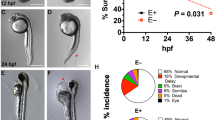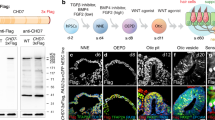Abstract
Little is known about the genetic pathways involved in the early steps of inner ear morphogenesis. Hoxa1 is transiently expressed in the developing hindbrain; its targeted inactivation in mice results in severe abnormalities of the otic capsule and membranous labyrinth 1. Here we show that a single maternal administration of a low dose of the vitamin A metabolite retinoic acid is sufficient to compensate the requirement for Hoxa1 function. It rescues cochlear and vestibular defects in mutant fetuses without affecting the development of the wildtype fetuses. These results identify a temporal window of susceptibility to retinoids that is critical for mammalian inner ear specification, and provide the first evidence that a subteratogenic dose of vitamin A derivative can be effective in rescuing a congenital defect in the mammalian embryo.
This is a preview of subscription content, access via your institution
Access options
Subscribe to this journal
Receive 12 print issues and online access
$209.00 per year
only $17.42 per issue
Buy this article
- Purchase on Springer Link
- Instant access to full article PDF
Prices may be subject to local taxes which are calculated during checkout






Similar content being viewed by others
References
Mark, M. et al. Two rhombomeres are altered in Hoxa-1 mutant mice. Development 119, 319–338 (1993).
Cantos, R., Cole, L.K., Acampora, D., Simeone, A. & Wu, D.K. Patterning of the mammalian cochlea. Proc. Natl. Acad. Sci. USA 97, 11707–11713 (2000).
Torres, M. & Giraldez, F. The development of the vertebrate inner ear. Mech. Dev. 71, 5–21 (1998).
Van de Water, T.R. & Conley, X. Neural inductive message to the developing mammalian inner ear: contact mediated versus extracelular marix interaction. Anat. Rec. 195A (1982).
Yntema, C.L. An analysis of induction of the ear from foreign ectoderm in the salamander embryo. J. Exp. Zool. 113, 211–244 (1950).
McKay, I.J. et al. The kreisler mouse: a hindbrain segmentation mutant that lacks two rhombomeres. Development 120, 2199–2211 (1994).
Frohman, M.A., Martin, G.R., Cordes, S.P., Halamek, L.P. & Barsh, G.S. Altered rhombomere-specific gene expression and hyoid bone differentiation in the mouse segmentation mutant, kreisler (kr). Development 117, 925–936 (1993).
McKay, I.J., Lewis, J. & Lumsden, A. The role of FGF-3 in early inner ear development: an analysis in normal and kreisler mutant mice. Dev. Biol. 174, 370–378 (1996).
Mansour, S.L., Goddard, J.M. & Capecchi, M.R. Mice homozygous for a targeted disruption of the proto-oncogene int-2 have developmental defects in the tail and inner ear. Development 117, 13–28 (1993).
Groves, A.K. & Bronner-Fraser, M. Competence, specification and commitment in otic placode induction. Development 127, 3489–3499 (2000).
Carpenter, E.M., Goddard, J.M., Chisaka, O., Manley, N.R. & Capecchi, M.R. Loss of Hox-A1 (Hox-1.6) function results in the reorganization of the murine hindbrain. Development 118, 1063–1075 (1993).
Fekete, D.M. Development of the vertebrate ear: insights from knockouts and mutants. Trends Neurosci. 22, 263–269 (1999).
Dupe, V. et al. In vivo functional analysis of the Hoxa-1 3′ retinoic acid response element (3′ RARE). Development 124, 399–410 (1997).
Marshall, H., Morrison, A., Studer, M., Popperl, H. & Krumlauf, R. Retinoids and Hox genes. FASEB J. 10, 969–978 (1996).
Dupe, V., Ghyselinck, N.B., Wendling, O., Chambon, P. & Mark, M. Key roles of retinoic acid receptors alpha and beta in the patterning of the caudal hindbrain, pharyngeal arches and otocyst in the mouse. Development 126, 5051–5059 (1999).
Niederreither, K., Subbarayan, V., Dolle, P. & Chambon, P. Embryonic retinoic acid synthesis is essential for early mouse post-implantation development [see comments]. Nature Genet. 21, 444–448 (1999).
Studer, M. et al. Genetic interactions between Hoxa1 and Hoxb1 reveal new roles in regulation of early hindbrain patterning. Development 125, 1025–1036 (1998).
Choo, D., Sanne, J.L. & Wu, D.K. The differential sensitivities of inner ear structures to retinoic acid during development. Dev. Biol. 204, 136–150 (1998).
Frenz, D.A., Liu, W., Galinovic-Schwartz, V. & Van De Water, T.R. Retinoic acid-induced embryopathy of the mouse inner ear. Teratology 53, 292–303 (1996).
Ross, S.A., McCaffery, P.J., Drager, U.C. & De Luca, L.M. Retinoids in embryonal development. Physiol. Rev. 80, 1021–1054 (2000).
Collins, M.D. & Mao, G.E. Teratology of retinoids. Annu. Rev. Pharmacol. Toxicol. 39, 399–430 (1999).
Sulik, K.K., Cook, C.S. & Webster, W.S. Teratogens and craniofacial malformations: relationships to cell death. Development 103, 213–231 (1988).
Kessel, M. & Gruss, P. Homeotic transformations of murine vertebrae and concomitant alteration of Hox codes induced by retinoic acid. Cell 67, 89–104 (1991).
Morriss-Kay, G.M., Murphy, P., Hill, R.E. & Davidson, D.R. Effects of retinoic acid excess on expression of Hox-2.9 and Krox-20 and on morphological segmentation in the hindbrain of mouse embryos. EMBO J. 10, 2985–2995 (1991).
Conlon, R.A. & Rossant, J. Exogenous retinoic acid rapidly induces anterior ectopic expression of murine Hox-2 genes in vivo. Development 116, 357–368 (1992).
Simeone, A. et al. Retinoic acid induces stage-specific antero-posterior transformation of rostral central nervous system. Mech. Dev. 51, 83–98 (1995).
Sulik, K.K., Dehart, D.B., Rogers, J.M. & Chernoff, N. Teratogenicity of low doses of all-trans retinoic acid in presomite mouse embryos. Teratology 51, 398–403 (1995).
Morsli, H., Choo, D., Ryan, A., Johnson, R. & Wu, D.K. Development of the mouse inner ear and origin of its sensory organs. J. Neurosci. 18, 3327–35 (1998).
Morrison, A., Hodgetts, C., Gossler, A., Hrabe de Angelis, M. & Lewis, J. Expression of Delta1 and Serrate1 (Jagged1) in the mouse inner ear. Mech. Dev. 84, 169–172 (1999).
Kiernan, A.E. et al. The Notch ligand Jagged1 is required for inner ear sensory development. Proc. Natl. Acad. Sci. USA 98, 3873–3878 (2001).
Levy, E., Liem, R.K., D'Eustachio, P. & Cowan, N.J. Structure and evolutionary origin of the gene encoding mouse NF-M, the middle-molecular-mass neurofilament protein. Eur. J. Biochem. 166, 71–77 (1987).
Verpy, E., Leibovici, M. & Petit, C. Characterization of otoconin-95, the major protein of murine otoconia, provides insights into the formation of these inner ear biominerals. Proc. Natl. Acad. Sci. USA 96, 529–34 (1999).
Torres, M., Gomez-Pardo, E. & Gruss, P. Pax2 contributes to inner ear patterning and optic nerve trajectory. Development 122, 3381–3391 (1996).
Wilkinson, D.G., Bhatt, S., Cook, M., Boncinelli, E. & Krumlauf, R. Segmental expression of Hox-2 homoeobox-containing genes in the developing mouse hindbrain. Nature 341, 405–409 (1989).
Cordes, S.P. & Barsh, G.S. The mouse segmentation gene kr encodes a novel basic domain-leucine zipper transcription factor. Cell 79, 1025–1034 (1994).
Wilkinson, D.G., Peters, G., Dickson, C. & McMahon, A.P. Expression of the FGF-related proto-oncogene int-2 during gastrulation and neurulation in the mouse. EMBO J. 7, 691–695 (1988).
Gavalas, A. et al. Hoxa1 and Hoxb1 synergize in patterning the hindbrain, cranial nerves and second pharyngeal arch. Development 125, 1123–1136 (1998).
Zhang, M. et al. Ectopic Hoxa-1 induces rhombomere transformation in mouse hindbrain. Development 120, 2431–2442 (1994).
Brigande, J.V., Kiernan, A.E., Gao, X., Iten, L.E. & Fekete, D.M. Molecular genetics of pattern formation in the inner ear: do compartment boundaries play a role? Proc. Natl. Acad. Sci. USA 97, 11700–11706 (2000).
Vendrell, V., Carnicero, E., Giraldez, F., Alonso, M.T. & Schimmang, T. Induction of inner ear fate by FGF3. Development 127, 2011–2019 (2000).
Ladher, R.K., Anakwe, K.U., Gurney, A.L., Schoenwolf, G.C. & Francis-West, P.H. Identification of synergistic signals initiating inner ear development. Science 290, 1965–1967 (2000).
Pirvola, U. et al. FGF/FGFR-2(IIIb) signaling is essential for inner ear morphogenesis. J. Neurosci. 20, 6125–6134 (2000).
Rossel, M. & Capecchi, M.R. Mice mutant for both Hoxa1 and Hoxb1 show extensive remodeling of the hindbrain and defects in craniofacial development. Development 126, 5027–5040 (1999).
Murakami, A., Thurlow, J. & Dickson, C. Retinoic acid-regulated expression of fibroblast growth factor 3 requires the interaction between a novel transcription factor and GATA- 4. J. Biol.Chem. 274, 17242–17248 (1999).
Brigande, J.V., Iten, L.E. & Fekete, D.M. A fate map of chick otic cup closure reveals lineage boundaries in the dorsal otocyst. Dev. Biol. 227, 256–270 (2000).
Gale, E., Zile, M. & Maden, M. Hindbrain respecification in the retinoid-deficient quail. Mech. Dev. 89, 43–54 (1999).
Trainor, P. & Krumlauf, R. Plasticity in mouse neural crest cells reveals a new patterning role for cranial mesoderm. Nature Cell. Biol. 2, 96–102 (2000).
Soprano, D.R. et al. A sustained elevation in retinoic acid receptor-beta 2 mRNA and protein occurs during retinoic acid-induced fetal dysmorphogenesis. Mech. Dev. 45, 243–253 (1994).
Pasqualetti, M., Ori, M., Nardi, I. & Rijli, F.M. Ectopic Hoxa2 induction after neural crest migration results in homeosis of jaw elements in Xenopus. Development 127, 5367–5378 (2000).
Acknowledgements
We thank P. Chambon, M. Mallo, M. Leid, O. Abdel-Samad and the referees for insightful comments on an earlier version of this manuscript. We are grateful to M. Poulet and T. Ding for excellent technical assistance. We wish to thank J-L. Vonesch and D. Hentsch for valuable help with imaging. We acknowledge the following colleagues for kind gifts of reagents: P. Chambon, R. Krumlauf, P. Gruss, D. Henrique, C. Petit and D.Wilkinson. M.P. was supported by fellowships from the European Commission (EEC), EMBO, and Association pour la Recherche sur le Cancer. R.N. was supported by DAAD and Fondation pour la Recherche Médicale (FRM) fellowships. M.D. was supported by fellowships from the Ligue Nationale Contre le Cancer and FRM. This work was supported by grants to F.M.R. from the EEC Quality of Life Program, the Association pour la Recherche sur le Cancer, the Ministère pour le Recherche and by institutional funds from CNRS, INSERM and Hôpital Universitaire de Strasbourg.
Author information
Authors and Affiliations
Corresponding author
Rights and permissions
About this article
Cite this article
Pasqualetti, M., Neun, R., Davenne, M. et al. Retinoic acid rescues inner ear defects in Hoxa1 deficient mice. Nat Genet 29, 34–39 (2001). https://doi.org/10.1038/ng702
Received:
Accepted:
Published:
Issue Date:
DOI: https://doi.org/10.1038/ng702
This article is cited by
-
Cell segregation in the vertebrate hindbrain: a matter of boundaries
Cellular and Molecular Life Sciences (2015)
-
Lack of brain serotonin affects postnatal development and serotonergic neuronal circuitry formation
Molecular Psychiatry (2013)
-
FGF signaling controls caudal hindbrain specification through Ras-ERK1/2 pathway
BMC Developmental Biology (2009)
-
MLL-mediated transcriptional gene regulation investigated by gene expression profiling
Oncogene (2003)
-
Ear see rescue
Nature Reviews Neuroscience (2001)



